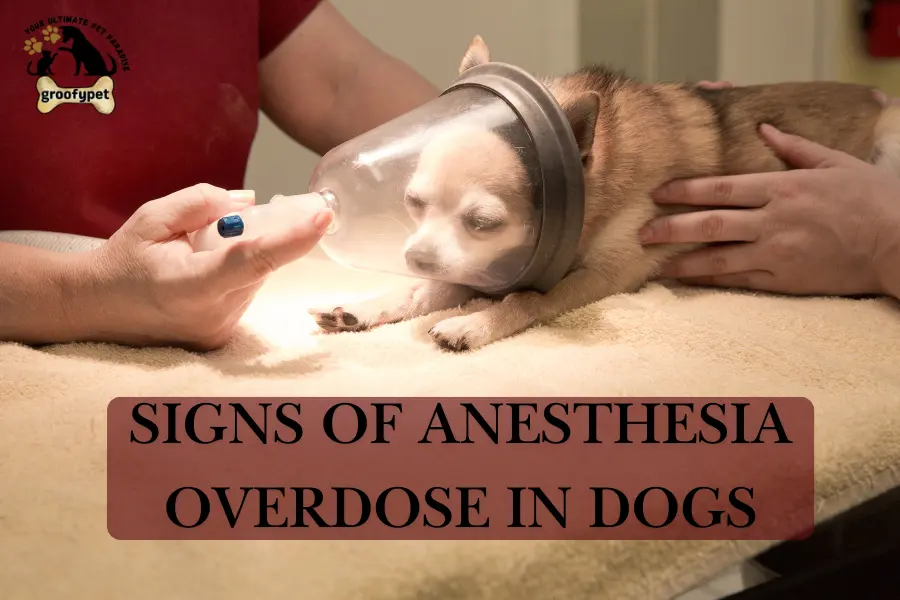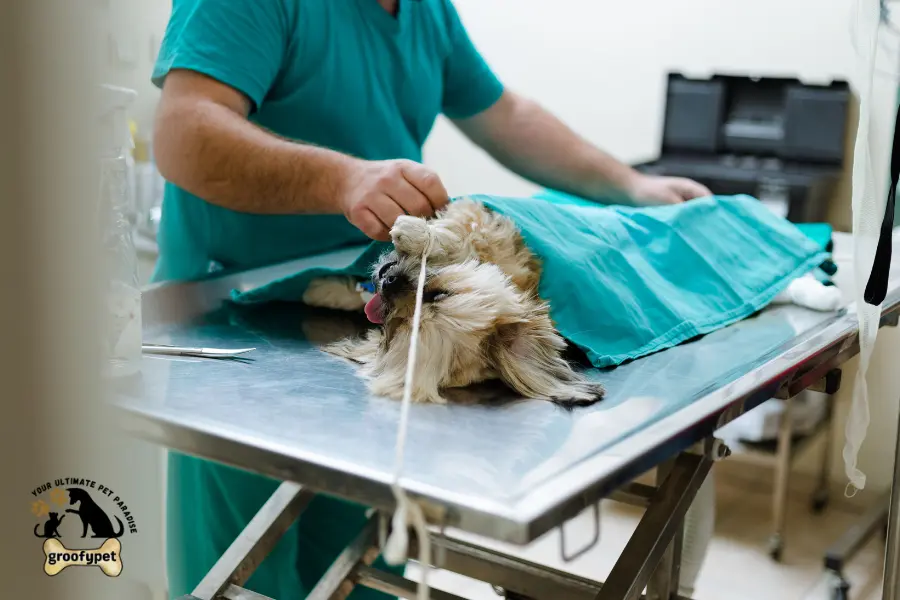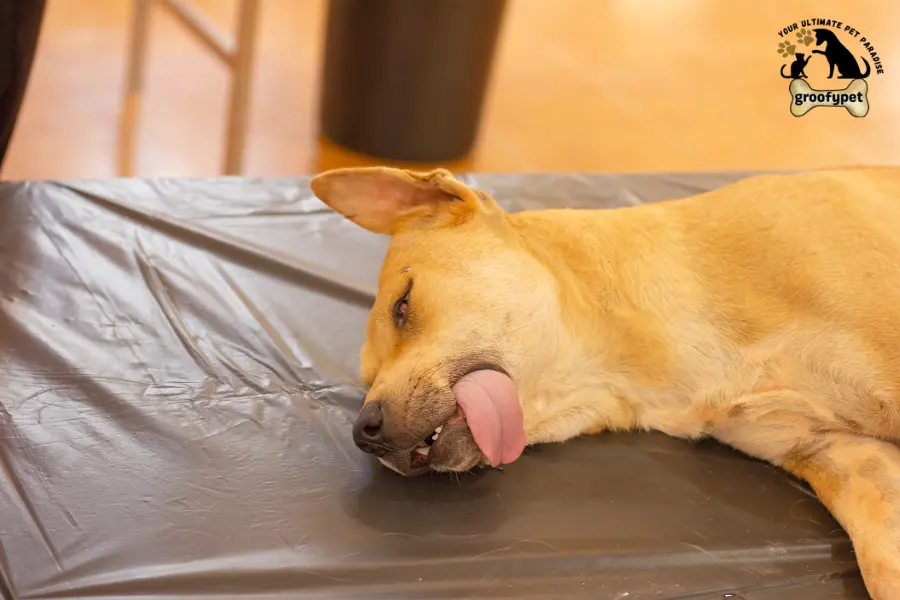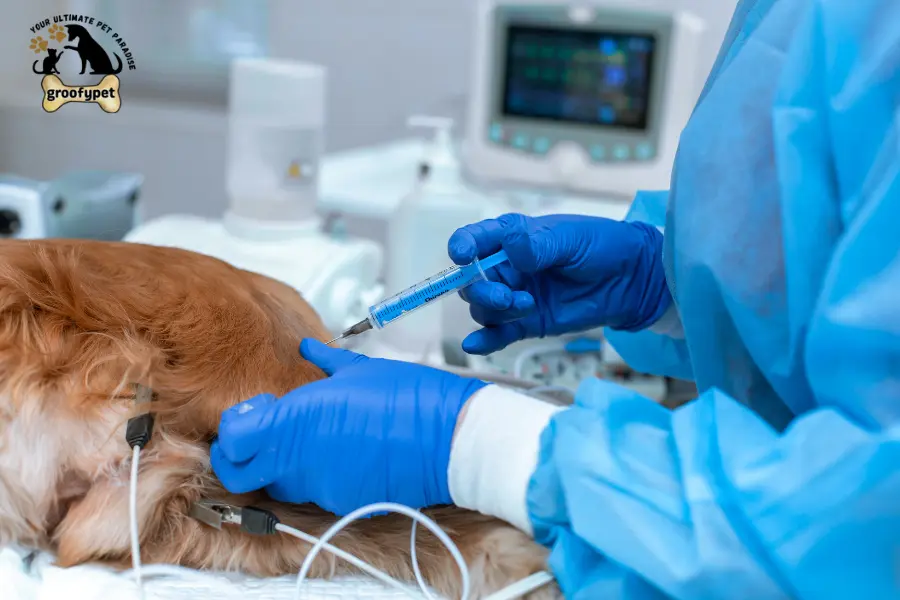
Every year many dogs need anesthesia for surgery or dental care. It helps them stay calm and pain-free. But when the dose is too high it can turn risky. Learning the signs of anesthesia overdose in dogs can save your pet life. Knowing what is normal and what is not helps you act fast if something feels wrong after your dog procedure.
Have you ever wondered why your dog is not waking up after surgery? Or why they seem weak and quiet for too long? These can be early signs of anesthesia overdose in dogs. Many pet owners feel confused when their dog acts strange after treatment. Understanding these signs helps you know when it is time to call the vet.
It’s scary to see your dog weak or not responding after surgery. You start to panic and ask yourself what went wrong. The truth is sometimes dogs can get too much anesthesia. Knowing the signs of anesthesia overdose in dogs helps you protect your best friend. When you understand the symptoms you can get help before it is too late.
Your dog is part of your family and their safety means everything. After surgery, you expect them to rest and recover soon. But what if something feels off? Slow breathing, pale gums or confusion might not be normal. These could be signs of anesthesia overdose in dogs. Knowing what to look for keeps your dog safe and helps you stay calm.
It helps you act fast and protect your dog from danger. This guide will help you understand the early and late signs, causes and what to do if you ever face this situation.
How anesthesia works?
Anesthesia makes your dog unconscious and stops pain during surgery. It will be local or general, depending on what the vet needs to do. Local anesthesia numbs one small part of the body. General anesthesia affects the whole body and makes your dog sleep deeply.

Vets give anesthesia through gas or an injection. They watch your dog breathing, heart rate, and body temperature. Dog anesthesia side effects happen if the dosage is too high or if the dog has health problems.
Why anesthesia is important for dogs?
- Anesthesia helps dogs stay calm during painful or stressful procedures.
- It keeps them from moving, biting or getting scared.
- Without anesthesia, surgery would be impossible.
- When done correctly, anesthesia is safe.
- But if your vet gives too much or your dog reacts badly, it can become dangerous.
- This is why knowing the signs of anesthesia overdose in dogs matters so much.
What causes anesthesia overdose in dogs?
1. Dosage mistakes
One main cause of overdose is an incorrect dose. A vet may miscalculate your dog weight or health status. Small breeds and older dogs are more sensitive. Even small amount affect their body.
2.Health conditions
Dogs with weak liver, heart or kidney function process anesthesia slowly. This allows the drug to build up in their system. Dog anesthesia reaction happens faster in such pets. Always tell your vet about your dog full medical history.
3. Human or machine error
Sometimes machines that deliver anesthesia fail or release too much gas. Human error like not checking oxygen flow also lead to overdose. Regular monitoring during surgery helps prevent this risk.
Early signs of anesthesia overdose in dogs
- The early signs of anesthesia overdose in dogs are often subtle but serious.
- You may notice your dog breathing slower than normal.
- The gums might look pale or white.
- Your dog may not respond when called.
- They might shiver or appear confused.
- Their heartbeat could slow down.
- Dog overdose symptoms like low body temperature or weak pulse also show early warning.
- Always keep an eye on your dog when they wake up from anesthesia.
Severe signs of anesthesia overdose in dogs
In serious cases, your dog may stop breathing or lose heartbeat. You might see blue gums or tongue, which shows a lack of oxygen. Seizures, shaking, or unresponsiveness are also severe signs. If your dog does not wake up even after several hours it may be an overdose.
Too much drooling, vomiting or twitching can also appear. Call your vet or an emergency clinic right away. These signs of anesthesia overdose in dogs mean your dog needs medical help immediately.
How vets diagnose anesthesia overdose?
Vets use tools to check if your dog is overdosed. They monitor heart rate, oxygen levels and breathing. Blood tests can show if organs like the liver and kidneys are under stress. They may use machines to check brain and body responses.
Anesthesia reaction in dogs also show in temperature changes and low oxygen. Quick tests and close observation help the vet take fast action to save your dog.
How vets treat anesthesia overdose in dogs?
When vets see the signs of anesthesia overdose in dogs they act quickly. They may give oxygen to help breathing. They might use fluids to flush drugs from your dog’s system. In some cases vets use reversal drugs that cancel anesthesia effects.
The vet keeps your dog under care and checks their body temperature and heartbeat. Good monitoring helps your dog recover safely. Dog recovery after anesthesia may take time but proper treatment helps avoid long term harm.
Recovery after an anesthesia overdose
After treatment, your dog may feel weak, tired, or dizzy. It is normal for dogs to act sleepy after anesthesia. Let your dog rest in a warm and quiet place. Give them fresh water when they wake up. Do not feed until your vet allows it.
Keep watching your dog breathing and body temperature. If your dog seems confused, drools too much or cannot stand call the vet. Good post surgery care supports full recovery.
How to prevent anesthesia overdose in dogs?
- Prevention is the best protection.
- Always choose an experienced vet for your dog.
- Share your dog full health records before any surgery.
- Ask your vet to check heart and liver function before giving anesthesia.
- Make sure they monitor your dog oxygen and pulse during surgery.
- Follow all fasting rules before the procedure.
- After surgery observe your dog for any strange signs.
- Knowing the signs of anesthesia overdose in dogs early helps prevent danger.
Which dogs are at higher risk?
Some dogs are more sensitive to anesthesia. Senior dogs have weaker organs that process drugs slowly. Puppies can react fast because of their small size. Dogs with liver or kidney problems are at higher risk. Small and toy breeds can get an overdose even from a small amount.
Overweight dogs can also face issues. Always tell your vet about your dog age, size and health before anesthesia.
What to do if you suspect an overdose?
If you think your dog had too much anesthesia, stay calm but act fast. Call your vet or go to the nearest animal clinic. Do not try to treat your dog at home. Keep your dog warm and still. Avoid feeding or giving water until the vet says it is safe.

The faster you act the better your dog chance of recovery. Always mention what drugs were used and when your dog got them.
How long do anesthesia effects last in dogs?
Light anesthesia wears off in a few hours. General anesthesia may take up to a full day. During this time your dog might sleep a lot or act disoriented. This is normal. But if your dog does not wake up or seems too weak it may signal an overdose.
Difference between normal recovery and overdose signs
It’s important to know what is normal and what is not. A sleepy dog after anesthesia is normal. A dog that does not wake up is not. Normal recovery may include slight wobbling or tiredness. Anesthesia side effects in dogs like long confusion, drooling or shaking could mean overdose. Normal gums are pink, but pale or blue gums are a red flag. If unsure, call your vet for guidance.
What dog owners should ask before anesthesia?
Good communication prevents mistakes. Ask your vet what kind of anesthesia will be used. Ask how your dog will be monitored. Discuss your dog’s age, weight, and any health problems. Learn what side effects to watch for after surgery. Ask how long your dog should rest. Make sure your vet knows about all medicines your dog takes. These questions build trust and safety for your pet.
My dog won’t wake up after anesthesia — what should I do?
If your dog does not wake up, this could mean a serious problem. The signs of anesthesia overdose in dogs can include long sleep or no response. Check if your dog is breathing and has a heartbeat. Look at the gums and tongue color. If they look blue or pale call your vet at once. Do not wait. Your quick action can save your dog life.
Common myths about dog anesthesia
Many owners believe anesthesia is always dangerous. But modern vet care makes it safe. Another myth is that small dogs don’t need much monitoring. In truth, they need even more care. Some think anesthesia always causes brain damage which is false.
Signs of anesthesia overdose in dogs eyes
The eyes can give early warning signs of trouble during anesthesia. If your dog’s eyes stay fixed, glassy, or do not respond to touch, it may be a sign of anesthesia overdose. Uneven or very large pupils can also mean the dose is too high.
During surgery, vets check the eyes to judge how deep the dog is under anesthesia. After surgery, your dog’s eyes should return to normal as they wake up. If they remain dull or lifeless, call your vet at once. The eyes can tell a lot about your dog’s health after anesthesia.
Dog anesthesia death rate
- Many pet owners worry about losing their dog under anesthesia, but it’s rare.
- The dog anesthesia death rate is very low, especially when done by trained vets.
- For healthy dogs, the risk is less than 0.05%.
- The risk is higher for senior dogs or those with heart or organ problems.
- Vets reduce risk by checking your dog’s blood and heart before surgery.
- They also watch breathing and oxygen during the procedure.
- Good care and modern drugs make anesthesia much safer today.
- Always discuss any concerns with your vet before surgery.
Dog anesthesia side effects whining
It’s common for dogs to whine after anesthesia. This dog anesthesia side effect happens because the dog feels confused, scared, or sore. Whining can also be a reaction to pain from surgery. Some dogs cry or shake because they don’t understand what’s happening as they wake up.
You can comfort your dog by keeping the room quiet and talking softly. If the whining doesn’t stop after several hours, ask your vet to check for pain or other issues. This behavior usually fades as your dog’s body clears the drug.
Signs of anesthesia overdose in dogs treatment
- When a dog shows signs of anesthesia overdose, vets act fast to save them.
- The first step is to give oxygen to help the dog breathe better.
- The vet may also start fluids through an IV to flush out extra drugs.
- In some cases, special medicines are used to reverse the anesthesia.
- The dog heart rate, temperature and breathing are checked closely.
- A vet may also use warming pads if the dog’s body gets too cold.
- Quick treatment for anesthesia overdose in dogs can prevent organ damage and help your dog recover faster.
- Always keep your dog at the vet clinic until they are stable and awake.
Signs of anesthesia overdose in dogs eyes
- Your dog’s eyes can show early clues of an overdose.
- During normal anesthesia, the eyes may stay still and half-closed.
- But if your dog is overdosed, the eyes may look fixed, glassy, or rolled back.
- Some dogs may not blink or respond when you touch near their eyes.
- In severe cases, the pupils may become very wide or very small.
- You may also notice red or pale eyes if oxygen levels drop.
- Watching your dog’s eyes after anesthesia helps you spot problems early.
- If your dog eyes look unusual or dull, call your vet right away.
Signs of anesthesia overdose in dogs vomiting
- Vomiting after anesthesia can mean your dog body is reacting badly to the drugs.
- A small amount of vomiting is normal once your dog wakes up but nonstop vomiting is a red flag.
- It could mean the anesthesia is still affecting the stomach or that your dog got too much.
- Vomiting can also cause dehydration and make breathing harder.
- If your dog vomits often or refuses food, contact your vet.
- The vet might give medicine to calm the stomach and prevent more vomiting.
- Always keep your dog’s head up to avoid choking.
What happens if a dog is given too much anesthesia?
If a dog gets too much anesthesia, their body slows down too much. The heart may beat very slowly or stop. Breathing can become weak or stop completely. The dog temperature drops and oxygen levels fall. Organs like the liver and brain may get damaged due to low oxygen.

In severe cases, this can cause a coma or even death. The good news is that vets can reverse some of these effects if they act quickly. Always choose a trusted vet who uses safe monitoring tools during surgery to prevent overdose.
Derdose symptoms
Dog overdose symptoms can appear during or after anesthesia. Early signs include slow breathing, weak heartbeat, pale gums, and confusion. The dog may not respond to touch or sound. In bad cases, there may be twitching, drooling, or seizures.
Some dogs collapse or do not wake up. Vomiting and low body temperature can also happen. If you see any of these signs, take your dog to the vet immediately. Fast action can save your pet’s life.
Symptoms of anesthesia in dogs
- When your dog gets anesthesia, you may notice a few normal effects.
- Your dog will be sleepy, slow, or unsteady when walking.
- Their eyes might look dull or half open.
- They may drool or shiver a little.
- These are normal symptoms of anesthesia in dogs as the drugs wear off.
- However if your dog stays unresponsive for too long, it may be a sign of trouble.
- Always keep an eye on your dog for any strange behavior.
Anesthesia overdose in dogs
Anesthesia overdose in dogs happens when too much of the drug enters the body. It can affect the dog’s brain, heart, and breathing. Older dogs and small breeds face more risk because their organs process drugs slowly.
Vets monitor dogs carefully to avoid this. But accidents can happen if the dose is wrong or if the dog has hidden health issues. The best way to prevent overdose is by sharing your dog’s full health record with the vet before surgery. Regular monitoring during and after the procedure also keeps your pet safe.
Symptoms of anesthesia wearing off in dogs
When anesthesia starts to wear off, your dog will slowly wake up. You may see wobbly walking, confusion, or deep sleep. This is normal. Some dogs may whine or cry as they become alert. Breathing and heartbeat return to normal levels.
But if your dog seems too tired, doesn’t respond, or shows dog overdose symptoms, it may be an overdose. Always watch how your dog wakes up and call your vet if something feels off.
Signs a dog is overdosing
When a dog is overdosing, they may show very clear signs. Breathing becomes slow or stops. The body might become cold or stiff. The gums and tongue may turn pale or blue. You might also see shaking or seizures. The dog may not respond when called. In some cases, there is vomiting or drooling. If your dog shows these signs a dog is overdosing, go to the vet immediately. Delays can be life-threatening.
How to tell if your dog is overdosing?
It’s not always easy to know when your dog is overdosing, but you can look for key signs. Check your dog’s breathing and heart rate. If they are slow or weak, that’s a warning. Look at the gums; they should be pink, not pale or blue.
Watch your dog eyes dull or fixed eyes can mean low oxygen. Touch their body; if it feels cold, the temperature may have dropped too low. Also, pay attention if your dog doesn’t wake up or acts confused for too long. These are common signs of anesthesia overdose in dogs and need quick vet help.
Frequently Asked Questions
How can I tell if my dog had too much anesthesia?
Your dog may breathe slowly act confused or not wake up. Gum turn pale or blue.
Can anesthesia cause death in dogs?
Yes if the overdose is not treated quickly. That is why watching signs matters.
How long does it take a dog to wake up from anesthesia?
Most dogs wake up in a few hours, but some may take longer depending on their health.
Is vomiting after anesthesia normal?
A small amount is normal, but nonstop vomiting needs vet care.
Should I feed my dog right after anesthesia?
Wait until your vet says it is safe. Feeding too early cause choking.
What is the safest anesthesia for old dogs?
Vets often choose mild drugs that wear off fast. Ask your vet for details.
Can anesthesia overdose cause long-term damage?
Yes it can affect the brain or organs if not treated in time.
How can I calm my dog after anesthesia?
Give them a quiet place to rest and keep them warm. Avoid loud noise or activity.
Final Thoughts
Knowing the signs of anesthesia overdose in dogs helps every dog owner protect their pet. Anesthesia is safe when used properly but mistakes or bad reactions happen. Watch your dog closely before and after surgery.
Share all health details with your vet and follow their advice. Stay calm and act fast if you see any danger signs. Your care and attention can make all the difference in keeping your dog safe and healthy.
Can Puppies Be Born Days Apart? Don’t Panic Until You Read This!
Can Dogs Eat Mangosteen? The Tasty Fruit with a Hidden Risk!



